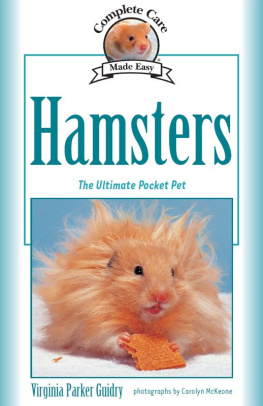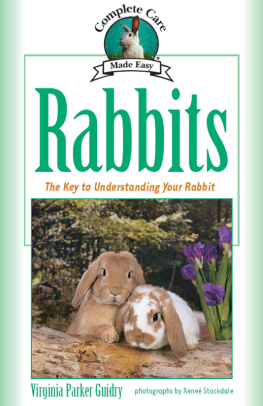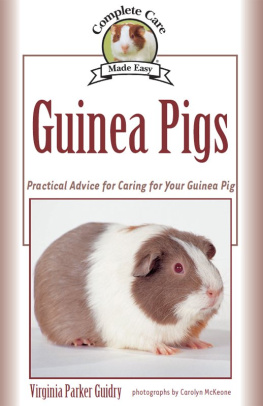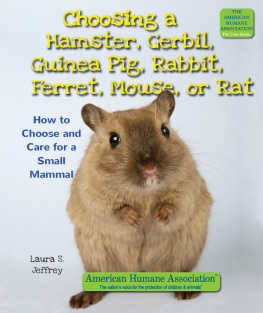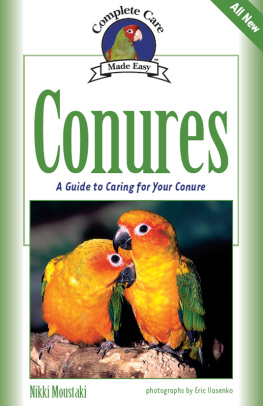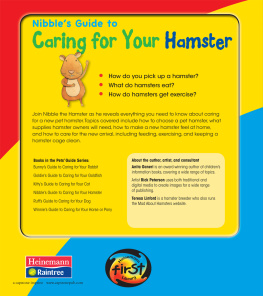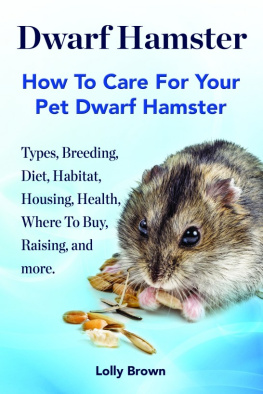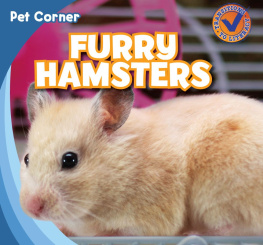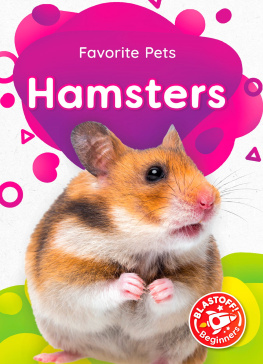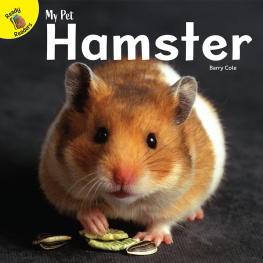
Vice President, Chief Content Officer: June Kikuchi
Vice President, Kennel Club Books: Andrew DePrisco
Production Supervisor: Jessica Jaensch
Assistant Production Manager: Tracy Vogtman
I-5 Press: Jennifer Calvert, Amy Deputato,
Lindsay Hanks, Karen Julian, Jarelle S. Stein
Photographs copyright 2004 by Carolyn McKeone
The hamster models in this book are courtesy of: Jordon Campbell, pp. cover, 3, 19, 20, 21, 31, 37, 48 (top and bottom), 59, 65, 67, 71, 79, 89, 92, 95, 108 (bottom); Pet Paradise, London, Ontario, pp. cover, 2, 6, 16, 27 (bottom), 30, 33, 34, 40, 41, 45, 73, 78, 81 (top and bottom), 87, 90, 91, 99, 100 (top and bottom), 108 (top), 112; Super Pet, London, Ontario, pp. 9, 10, 11, 12, 15, 17, 22, 25, 27 (top), 38, 42, 53, 57, 61, 62, 64, 77, 85, 88, 102, 103, 105, 115; and Jillian Mundt, pp. 54, 55, 70, 75, 106.
Text copyright 2004 by I-5 Press
All rights reserved. No part of this book may be reproduced, stored in a retrieval system, or transmitted in any form or by any means, electronic, mechanical, photocopying, recording, or otherwise, without the prior written permission of I-5 Press, except for the inclusion of brief quotations in an acknowledged review.
The Library of Congress has cataloged an earlier printing as follows:
Guidry, Virginia Parker.
Complete care made easy. Hamsters : the ultimate pocket pet / by Virginia Parker Guidry ;
photographs by Carolyn McKeone.
p. cm.
Includes index.
ISBN: 1-931993-31-9 (softcover : alk. paper)
ISBN-13: 978-1-931993-31-9
1. Hamsters as pets. I. Title: Hamsters. II. McKeone, Carolyn. III. Title.
SF459.H3G85 2005
636.9356dc22
2004003349
I-5 Press
A Division of I-5 Publishing, LLC
3 Burroughs
Irvine, California 92618
Printed and bound in China
13 12 11 6 7 8 9 10
Acknowledgments
WHILE WRITING IS A SOLITARY TASK, NO BOOK IS WRITTEN without the help of others. This book is no exception. So, hats off and many thanks to the hamster enthusiasts who answered questions, made suggestions, and clarified information. And, thank you to Dr. Max of long ago, who delighted a youngster with imaginative hamster stories.
V.P.G.
FOR PAMELA HANNANT, MAY YOUR LIFE BE ENRICHED by all living creatures. Also, in memory of my dear husband Pete, who encouraged me to return to photographing animals and birds.
Carolyn

Contents
Foreword
One of the first things I learned about hamsters is there is a lot more to them than meets the eye. Did you know there are more than twenty hamster species? Dont worry, you dont have to learn about all of them as only a few are kept as pets, but each species is unique. This book makes learning about these fascinating pets funits easy to read and the answers to your questions are easy to find. The more you read, the more youll discover why the hamster is one of the worlds most popular pets.
My sister, Andrea, adopted a golden hamster when she was in the 10th grade. Looking back, she remembers she didnt give the hamster the attention it needed, and especially didnt clean the cage enough. In college, her boyfriend (now her husband) got her a hamster named Lucy. Unfortunately, Lucy was pregnant, and instead of having one pet, my sister found herself with multiple hamsters. The original pet store refused to take back the babies, but she did finally find a store that would take them.
Experiences like my sisters can be typical for small animal owners. Although we all must learn some things through experience, it benefits both you and your pet to begin your relationship on the right footarmed with the knowledge of proper hamster care. So whether youve just adopted an adorable and fun-loving hamster who will give you hours and hours of enjoyment and entertainment or are just thinking about getting one, Hamsters: The Ultimate Pocket Pet can help you make sure your new pet thrives and not just survives. Read on, and get ready for a wonderful and rewarding friendship!
Melissa L. Kauffman, Editorial Director, I-5 Publishing, LLC



Hamsters first came to the United States in 1938.
H AMSTERS. S OME CALL THEM THE WORLDS MOST popular small pet. To be sure, hamsters are a much-loved and much-enjoyed pet in many countries. They are the primary subject of many books, newsletters, countless Internet Web sites, and even a television show. Because of hamsters, clubs are founded, children are introduced to the world of pets, and companies manufacture an array of specialty products. Amazing, isnt it?
Yes and no: It is amazing that such a tiny critter has such a huge influence. But when you learn more about hamsters, you begin to understand the almost magical spell that they have cast upon their adoring fans.
Rodentia
The hamster is a member of the largest group of mammals, called Rodentia. The Rodentia order also includes beavers, muskrats, porcupines, squirrels, prairie dogs, and many other small mammals. With more than two thousand living species categorized in about thirty different families, rodents make up over 40 percent of mammal species. Hamsters belong to the subfamily muridae, which consists of more than 1,100 species including rats, mice, voles, muskrats, lemmings, and gerbils. Within the muridae family, there are more than twenty species of hamsters. Only a few are kept as pets, though. The others live in the wild throughout the world in areas as diverse as Africa, Asia, and Europe. The Rodentia order does not include rabbits, as many people mistakenly believe. Rabbits and hares belong to the Lagomorpha order.

Hamsters belong to the same family as rats, mice, and gerbils.
Rodents have extremely diverse lifestyles. Some species live in rain forests, others live underground, and still others make their homes in deserts. They range in size from pygmy mice weighing .05 kilogram to capybaras weighing some 70 kilograms.
Like all rodents, a hamster has teeth made especially for gnawing. All rodents have a single pair of upper and a single pair of lower incisors, followed by a gap (diastema), and then one or more pairs of molars or premolars. No rodent has more than one incisor in each quadrant, and no rodent has canine teeth. Rodent incisors are rootless, which means they grow continuously. Rodents gnaw with their incisors by pushing the lower jaw forward and chew with the molars by pulling the lower jaw backward. As a rodent gnaws, the incisors grind against each other and wear down the soft dentine. This natural wearing keeps the teeth sharp and at a proper length. To accommodate their chewing patterns, rodents have extremely strong jaw muscles.

